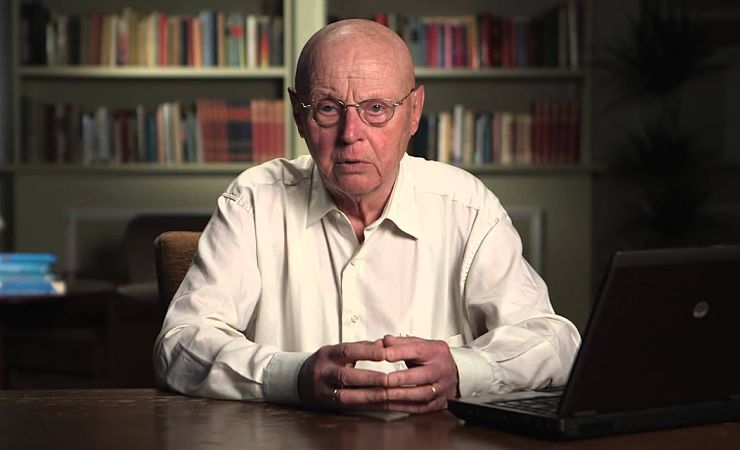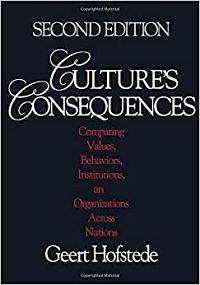Geert Hofstede, 1928-2020: The Engineer of Cross-Cultural Psychology

Twenty years ago the second edition of one of the more influential books in social science, Geert Hofstede’s Culture’s Consequences: Comparing Values, Behaviors, Institutions and Organizations Across Nations, appeared. The book, first published in 1980, described the “free-range” Dutch professor’s attempt to capture the role of culture in determining a person’s values. Culture’s Consequences captured both popular and academic attention – it’s No. 15 on this list of most cited works, for example.
“Every day,” Sjoerd Beugelsdijk and Chris Welzel wrote three years ago in the Journal of Cross-Cultural Psychology, “another 45 publications worldwide cite the cross-cultural work of Geert Hofstede and Ronald Inglehart,” name-checking another survey-wielding scholar who, like Hofstede, died last year.
“Cross cultural psychology begins as a serious discipline from the publication of his book, which … is one of the most widely cited pieces of social science that we have today,” said psychologist Michael Harris Bond, a friend and collaborator of Hofstede’s.
The theory of cultural dimensions as presented in the second edition described six “dimensions” of national culture. The first four dimensions –power distance, individualism, uncertainty avoidance, and masculinity – Hofstede divined while from a huge trove of worker survey responses from Hofstede’s one-time employer, IBM. That data, Hofstede believed, was “probably the largest matched-sample cross-national database available anywhere” at that time. After the publication of the first edition, he developed the other dimensions after collaboration with two other scholars – long-term orientation with Bond, and indulgence vs. restraint (or Confucian dynamism) with Michael Minkov. To Hofstede, these dimensions were constructs, useful for deciphering a complex world but not something to reify.
“Hofstede,” noted Beugelsdijk and Welzel, “was the first researcher to reduce cross-national cultural diversity to country scores on a limited number of dimensions. Hofstede’s work provided researchers with a consistent quantification of cultural differences between countries, causing a surge in empirical studies about the impact of culture on the activities and performance of multinational firms.”
Bond also focused on the importance of firing up the organized investigation of cross-cultural differences. Hofstede “gave us markers on the playing field, so we could get on with the game,” Bond said in an interview for An Engineer’s Odyssey, a 2014 documentary about Hofstede. “Before that it was just a bunch of kids playing pick-up soccer on this wide-open field.”
Writing in 1997 for the journal International Studies in Management & Organization, Malcolm Chapman argued “Hofstede’s work became a dominant influence and set a fruitful agenda. There is perhaps no other contemporary framework in the general field of ‘culture and business’ that is so general, so broad, so alluring, and so inviting to argument and fruitful disagreement.…Second, although Hofstede’s work invites criticism on many levels, one often finds that Hofstede, in self-criticism, has been there first. Third, although Hofstede’s work is based on a questionnaire drawn from social psychology that was not expressly designed for the purpose to which it was later put, Hofstede brings to his discussion such a wealth of expertise and erudition from outside the questionnaire that many criticisms of ‘narrowness’ are withered on the tongue.”
As economist Arndt Sorge observed in An Engineer’s Odyssey, people weren’t always relaxed when meeting Hofstede: “they don’t know whether they owe him open criticism or admiration.”
For his part, Hofstede accepted the criticism as part of innovation. “If you have a message, you have people who agree and who disagree, If you have no people who disagree, you have no message. You’re only confirming the things that everybody has believed already.”
In his own case, “I met sufficient acceptance that I did not bother about the resistance so much. Actually. I was more surprised with the acceptance than I was with the resistance.”
Addressing Hofstede’s legacy shortly after the scholar’s death, Terence Jackson wrote in the International Journal of Cross-Cultural Management that “Hofstede set the agenda for a critical cross-cultural management studies, which challenged existing theory, questioned the accepted wisdom of universality in management studies. This is the legacy for which he should be remembered.”
Gerard Hendrik “Geert” Hofstede was born on October 2, 1928, in Haarlem, the Netherlands, the third and youngest child and second son of his family. He grew up in The Hague and Apeldorn as a precocious student, jumping two grades and therefore being simultaneously the youngest and the smartest student in class. He graduated gymnasium, or high school, in 1945, the same year that the five-year Nazi occupation of the Netherlands came to an end.
Hofstede entered technical college studying engineering, and spent a year doing internships. One saw him serve as an assistant engineer in a ship that sailed to Indonesia, opening up new vistas for a young man whose world until now went little beyond the Netherlands. In 1947 he started at Delft Technical University, receiving a master’s in mechanical engineering in 1953. While there, he headed a national student organization for a year, exposing him to various other universities and academic cultures.
Leaving Delft, Hofstede completed his two years of mandatory military service before setting sights on a career in private industry as a manager. Deciding that, as he explained in the 2014 documentary about him, “If I really want to be a manager, I want to know how it feels to be managed …as an ordinary worker,” he first took a job in 1955 as a skilled mechanic in Amsterdam. While he made friends among his team, as he explained in that documentary, working essentially under false pretenses and incognito proved upsetting even as it proved instructive, and he left after four months.
That same year he married Maaike A. van den Hoek, who survives him. They had five children, including Hofstede’s future co-author, their son Gert-Jon. “I think,” Hofstede said, “she was 90 percent of my success.”
Over the next 10 years Hofstede would work with three different Dutch companies, starting with a technical remit but then tending toward personnel –giving him valuable insights he would later use for a PhD thesis. He would note later how his technical education influenced his enduring interest in people and culture, as the mechanical bent made him want to “understand how things fit together” in the social sphere.
In 1965 he started down two different paths that would eventually prove complementary – studying social psychology and working for the multinational firm IBM. The roots of the amalgamation began at Delft, where reading A.M. Kuylaars’s Werk en Leven (Work and Life) left Hofstede considering the split between the internal and the external in a person. ”The day I read that,” he said later, “my destiny was more or less set.”
IBM in Netherlands offered him a variety of positions, and he chose the one the focused on the company’s international operations. At the same time, he started graduate work toward a PhD at the University of Groningen, which would result in a Ph.D in social psychology. Despite graduating cum laude, Hofstede admitted “I never felt completely accepted as a psychologist.”
But as his star rose at IBM, he started to feel the odd man out there, too. He set up the huge company’s Personnel Research Department, and then, working alongside David Sirota, developed a standardized attitude survey.
As his son Gert Jan wrote after his father’s death, “Under Geert’s impulse, IBM collected opinion survey data from across over 50 countries. They were about mundane matters such as salary, tenure, working relationships. What Geert discovered is that it did not matter much whether a respondent was white- or blue- collar, male or female, new or ancient. What did matter was from which country they came.”
By 1973, this was a treasure trove of information: some 117,000 questionnaires. “It was by sheer vision and gumption,” said Gert Jan, “that he realized the data’s importance, obtained unpaid leave, and embarked on his pioneering journey.”
His first step was a two-year sabbatical from IBM which allowed him to lecture on organizational behavior at the Institut pour l’Etude des Methodes de Direction de l’Entreprise in Lausanne, Switzerland (now the International Institute for Management Development). Returning to IBM after the sabbatical, he saw that his interests and the company’s diverged, and so he left IBM for good in 1973. As a parting gift, IBM gave Hofstede all the attitude survey data. (“IBM has never been a good user of my research,” Hofstede wryly observed later.)
He lighted at a brand-new think tank, the European Institute for Advanced Studies in Management in Brussels, and served as a visiting professor of management at INSEAD in Fontainebleau, France. Over the next six years wrote Culture’s Consequences, building it on the IBM data he’d been given and on surveys he’d conducted with international MBA students.
The book’s future importance did make his “fat manuscript” an easy sell when it came time to publish. Hofstede offered the book to publisher after publisher, 19 in all. One after the other wrote back with a variation on “this is very interesting, but it doesn’t fit our collection.” One day Hofstede’s mail contained two letters from the same publishing house, SAGE (the parent of Social Science Space). One letter was the pro forma response Hofstede expected, but the other was from SAGE’s founder, Sara Miller McCune, asking for a copy of the manuscript she’d heard about.
SAGE not only ended up publishing the book, and its second edition, but Miller McCune suggested a snappier title. “After rereading portions of the manuscript,” she recalled, ”I suggested the title Culture’s Consequences, which Geert accepted gratefully and eagerly. When it went on to become one of the Financial Times London One Hundred Top Business Books of the year, no one was prouder than I.” The book has been a best-seller for SAGE since.
Hofstede later reflected on the way he hopscotched his way to academic prominence. “It was an idealistic thing to work as a factory worker, it was an idealistic thing to try and become a psychologist if you had 10 years work as an engineer, it was certainly an idealistic thing to leave my job at IBM just because they didn’t want me to study the things I wanted to study.”
Hofstede continued in the academic world – mostly. In 1980 he and Bob Waisfisz founded the Institute for Research on Intercultural Cooperation, and Hofstede served as the first director and later a senior fellow after his retirement.
The same year of IRIC’s founding and just as Culture’s Consequence was appearing, Hofstede took a role as director of human resources for Fasson Europe, an industrial firm based in Leiden. He spent three years at Fasson, returning to academia in 1983 to become dean of the Semafor Senior Management Program in Arnhem, and in 1986 was appointed professor of organizational anthropology and international management at the University of Maastricht, where he remained until his 1993 retirement.
As a memoriam on the Maastricht website detailed, “Geert was invited to work at the UM also to set up the curriculum of International Management. Later on, this field developed into the highly successful field of International Business, but Geert must be credited for having laid the groundwork.”
As noted, in 2001 the second edition of Culture’s Consequences appeared. It was a major revision, with much of the work a discussion of the applications and replications of Hofstede’s work other researchers had conducted since 1980.
Upon retirement, he became professor emeritus at Maastricht and started to collect professional honors, including 11 honorary doctorates, honorary professorships and multiple fellowships, such as with the Academy of International Business and the Academy of Management. In keeping with the idea that he had never felt fully at home in psychology, one of the most meaningful honors he received was an honorary fellowship the International Association for Cross-Cultural Psychology awarded him in 2006.
Hofstede died on February 12, 2020, age 91.
“All in all,” his son Gert Jan has written, “Geert’s story is one of remarkable perseverance, acuity of vision, cross-disciplinary endeavor and serendipity. Fortunately, many others have thought to extend or build upon his work. This is how it should be. We need to move on in our 21th century – but Geert’s messages should be in our backpacks.”
SOME READINGS
Social Science Space will be hosting some essays looking at Geert Hofstede and the impact of Culture’s Consequences in the next few weeks. In the meantime, here’s a sampler of journal articles looking at similar themes.
“Hofstede’s model of national cultural differences and their consequences: A triumph of faith – a failure of analysis” | Brendan McSweeney in Human Relations
“The legacy of Geert Hofstede” | Terence Jackson in the International Journal of Cross Cultural Management
“Dimensions and Dynamics of National Culture: Synthesizing Hofstede With Inglehart” | Sjoerd Beugelsdijk and Chris Welzel in the Journal of Cross-Cultural Psychology
“Long-term orientation and the passage of time: Is it time to revisit Hofstede’s cultural dimensions?” | Douglas Chun, Zhen Zhang, Eric Cohen, Liviu Florea and Omer F. Genc in the International Journal of Cross Cultural Management
“A Reconsideration of Hofstede’s Fifth Dimension: New Flexibility Versus Monumentalism Data From 54 Countries” | Michael Minkov, Michael H. Bond, Pinaki Dutt, Michael Schachner, Oswaldo Morales, Carlos Sanchez, Janar Jandosova, Yerlan Khassenbekov and Ben Mudd in Cross-Cultural Research





























































































For a recent critique of Hofstede’s work see McSweeney B (2024) Hofstede’s Imagined Cultures Chapter 8 in https://www.routledge.com/Hofstede-Matters/Magala-Erten-Bell-Claes-Yazici-Karabag/p/book/9781032518442